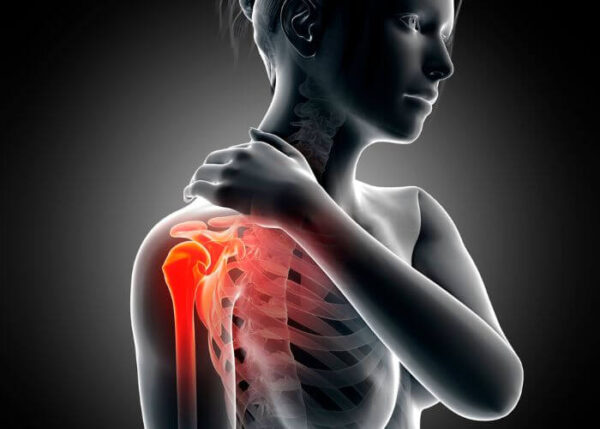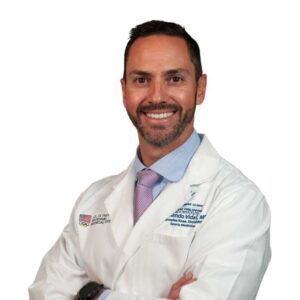What is shoulder instability?
The shoulder is a remarkable joint, mobile and strong. It helps the arm rotate, lift and move overhead. Unfortunately, the shoulder’s mobility can come at a cost, making it more susceptible to dislocation and shoulder instability. Shoulder instability can occur from a traumatic event (shoulder dislocation) or can occur in the setting of repetitive microtrauma in patients with hyperlaxity (joint looseness). Dr. Armando Vidal, orthopedic shoulder specialist, serving patients in Vail, Aspen and the surrounding Denver, Colorado communities has extensive experience in working with patients who are suffering from shoulder instability.

What is the cause of shoulder instability?
If a shoulder has dislocated, even one time, it is more prone to shoulder instability and recurring shoulder separation or dislocation. The ligaments and muscles in the shoulder can stretch and even tear during a dislocation which causes shoulder weakness and instability. During a dislocation, the labrum – a rim of cartilage that lines the socket joint and holds the ball of the shoulder in place – tears, causing further instability. A torn labrum can result in an increased tendency for repeated dislocations. Additionally, in some patients (typically older than 40) a shoulder dislocation can be associated with a traumatic rotator cuff tear.
Who is at risk for shoulder instability?
Patients in Vail, Aspen and the surrounding Denver, Colorado communities are most at risk for shoulder instability if they have sustained a prior shoulder dislocation. Shoulder dislocations often occur in patients active in contact sports such as hockey, basketball, soccer or football. Other sports that can contribute to shoulder instability include volleyball, tennis, swimming and pitching. Overhead motions can place the shoulder in a position that can lead to increased stress on the ligaments and muscles that support the shoulder. These positions can also create a risk for shoulder instability.
What are the symptoms of an unstable shoulder?
- Popping and immediate pain, caused by a shoulder injury
- Repeated shoulder dislocations
- Partial dislocations of the shoulder (called subluxation episodes)
- Feeling of the shoulder giving way or popping out of joint
- Feeling of the shoulder joint being loose
- Shoulder easily slips out of joint
- Grinding in the joint
- Weakness, especially in the rotator cuff tendon
- Numbness in the arm and fingers
How is shoulder instability diagnosed?
Dr. Vidal will obtain a complete medical history and perform a physical examination. He will check for areas of tenderness, determine range of motion and shoulder strength. The degree of shoulder joint laxity will also be determined with careful tests. If he suspects bone involvement, or other problems he may request an x-ray or an MRI scan to rule out other causes of shoulder pain and instability.
How is shoulder instability treated?
Dr. Vidal has several treatment options available depending on the patient age, level of activity and the severity of shoulder instability.
Non-Surgical Treatment:
May include the use of a shoulder sling for immobilization to help with pain and assist in proper healing. A combination of ice, rest and physical therapy may be used to help strengthen the muscles around the shoulder joint. In patients without a rotator cuff tear and at a low risk of recurrence, this is typically the best path.
Surgical Treatment:
The decision for surgery is individualized to each patient. Surgery maybe recommended for some patients who are at a high risk for recurrence even after one dislocation.
This could include:
- Young, contact athletes
- Consequence athletes (patients where the risk of a second dislocation puts them at risk for a more serious injury or death – such as mountain climbers, first responders, big wave surfers, etc)
- Traumatic rotator cuff tears
- Critical bone loss or fractures
Additionally, patients who suffer from recurrent instability may require surgery. Dr. Vidal specializes in arthroscopic surgery of the shoulder which is minimally invasive and allows a quicker return to normal activities. He also has extensive experience with complex, open procedures for treating shoulder instability in patients who have had multiple prior injuries and/or prior shoulder surgery. Dr. Vidal is happy to discuss the perfect surgical solution and treatment plan for your shoulder instability.
How long is the recovery after shoulder instability surgery?
If surgery is needed for your shoulder instability, the recovery depends on the type of procedure Dr. Vidal performed. Most patients are in a sling for 4-6 weeks after surgery. Usually patients in the greater Denver area will begin range of motion of the hand, wrist and elbow the day after surgery. Most patients are able to write and use their arm for daily activities such as eating within 3 to 7 days after surgery. Dr. Vidal will assign a specialized physical therapy program 1 to 4 weeks after surgery. Full range of motion usually returns after 6 to 8 weeks, with full recovery in 4-6 months.
Shoulder Instability Specialist
Have you experienced recent or frequent shoulder trauma? If so, you may be at risk of developing shoulder instability. This condition causes pain, weakness, and possible frequent dislocations in the affected shoulder. Arthroscopic shoulder specialist, Doctor Armando Vidal provides diagnosis as well as arthroscopic stabilization surgery for patients in Vail, Aspen, and the surrounding Denver, Colorado communities who are experiencing shoulder instability. Contact Dr. Vidal’s team today!

Locations
180 S Frontage Rd W
Vail, CO 81657
226 Lusher Court
Ste 101
Frisco, CO 80443
322 Beard Creek Road
Edwards, CO 81632


